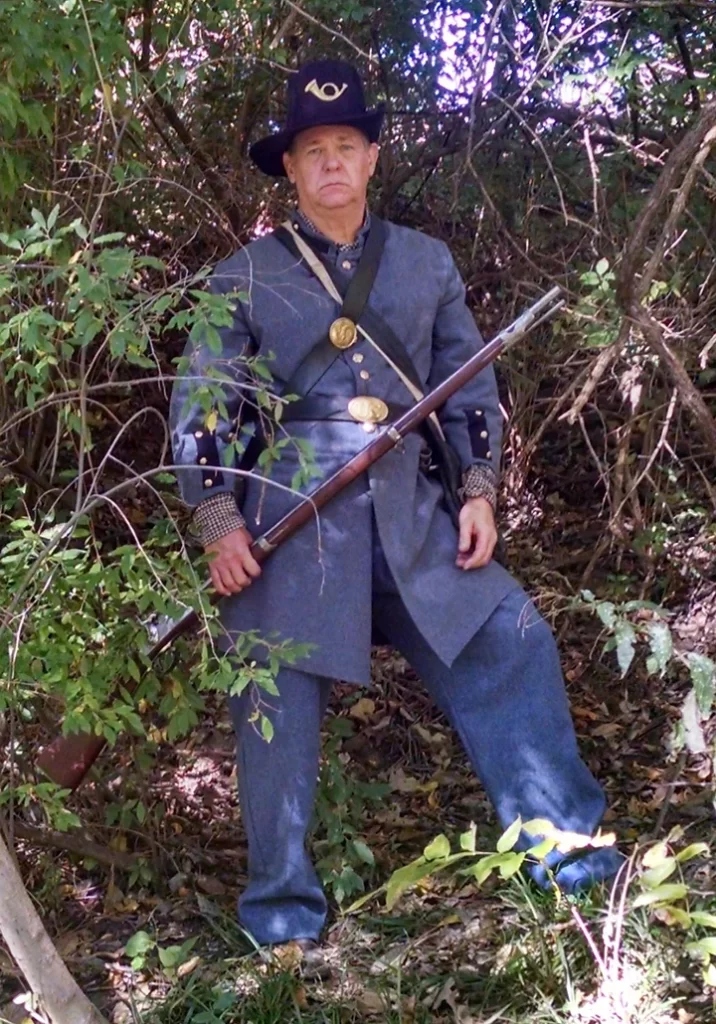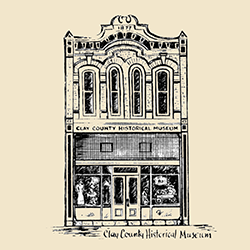By Tony Meyers
 In September of 1861, Liberty and Clay County briefly became a focal point for the Civil War in Missouri. It was a difficult time for local citizens. Many were staunchly pro-Southern while others were aligned with the North supporting the Union. Although the State of Missouri had not seceded from the Union, pro-Southern Missouri State Guard units had been authorized by the Missouri State Legislature. Approximately 4,000 new recruits from counties in northwest Missouri consolidated in St. Joseph and on September 15th began marching south with a goal to join up with other Southern forces under General Sterling Price at Lexington. Northern troops were ordered to intercept them. Their fates would cross in Liberty and on the road towards the Missouri river in southern Clay County.
In September of 1861, Liberty and Clay County briefly became a focal point for the Civil War in Missouri. It was a difficult time for local citizens. Many were staunchly pro-Southern while others were aligned with the North supporting the Union. Although the State of Missouri had not seceded from the Union, pro-Southern Missouri State Guard units had been authorized by the Missouri State Legislature. Approximately 4,000 new recruits from counties in northwest Missouri consolidated in St. Joseph and on September 15th began marching south with a goal to join up with other Southern forces under General Sterling Price at Lexington. Northern troops were ordered to intercept them. Their fates would cross in Liberty and on the road towards the Missouri river in southern Clay County.
Scott to join forces at Liberty before moving against the Missouri State Guard.
During the day on Monday the 16th the Missouri State Guard soldiers were warmly greeted by citizens as they paraded past the county courthouse on the Liberty square. Under orders from General Price, General David Rice Atchison met these Southern troops in Liberty to assist their efforts to reach Lexington. Soon they began the process of crossing the Missouri river south of Liberty using flatboats at Blue Mills Landing.
Lt. Colonel John Scott, commanding 500 men of the Third Iowa Infantry and 100 pro-Northern Missouri Home Guard volunteers from Adair and Caldwell counties, completed their march from Cameron shortly after sunrise on Tuesday the 17th. Muskets and rifles crackled as the Southern troops that remained were pushed through the streets of Liberty. Scott and his men set up camp on the hill north of town. Fifteen hundred additional Federal troops from Ohio and Illinois under the command of Colonel Robert Smith were enroute from Buchanan County. The plan was for Smith and Scott to join forces at Liberty before moving against the Missouri State Guard.
Scott sent a scout to seek out Smith and his command but they could not be located. Scott waited. Around noon he dispatched a small contingent of 20 cavalrymen of the Home Guard to seek out the enemy. These scouts made their way down the narrow and wooded road leading to the Missouri river. About two miles south of town Colonel Richard Chiles and 300 of his troops waited in ambush. The Northern scouts rode directly into the trap. Four men were killed instantly and a fifth was severely wounded. The survivors retreated back towards Liberty.
Scott knew that the Missouri State Guard soldiers were actively crossing the river and would soon be making their way to Lexington. He determined that action must be taken with or without support from Smith. About 3:00 pm Scott and his 600 men began marching through Liberty towards the landing. They marched as a column, four men wide down the narrow road. At about 4:00 pm, as the column neared John Beauchamp’s corn field, shots rang out. Scott and his men had marched directly into a well placed ambush. Six hundred Southern troops commanded by Colonel Chiles and Colonel Jeff Patton had concealed themselves in the woods and in ravines along the road. Scott’s men were taking fire from the front, left and right. It was a desperate situation for the Northern troops as many fell wounded and dying. The narrow road and thick woods made it impossible for Scott to form an effective firing line. Instead they moved into the woods on both sides of the road and fought from there. Scott ordered the single cannon that was available forward into position. Only two shots could be fired before the artillerists and their horses were taken out of battle. Southern troops moved forward in an effort to capture the cannon but were pushed back. Northern soldiers fought to secure the cannon as casualties on their side continued to mount. The Southern force maintained the upper hand while the battle raged on with significant intensity. Scott and his men fought off an attempt by the Missouri State Guard to move past them on the right. Gradually the Northern soldiers pulled back towards Liberty as the Southern troops pursued. While retreating, Scott formed a firing line and delivered a musket volley which convinced the Southern soldiers to break off their pursuit.
The battle, which lasted about an hour, was a decisive victory for the Pro-Southern Missouri State Guard. Nineteen Union troops died as a result of the fighting that occurred that day. Approximately 80 were wounded. Three men of the Southern command were killed; 18 were wounded.
Scott and his troops returned to Liberty where they established a hospital in Jewell Hall on the William Jewell College campus. Colonel Smith and his contingent of 1,500 Union soldiers arrived in Liberty a few hours after the battle was complete. Surviving members of Scott’s command, buried their dead comrades near Mt. Memorial Cemetery, which today is part of the William Jewell campus. Those soldiers were moved to the Fort Leavenworth National Cemetery in 1912.
After the battle, the Missouri State Guard troops successfully completed their crossing of the Missouri
river at Blue Mills Landing and made their way east where they supported General Price in defeating Union forces at the Battle of Lexington.
THE BATTLE OF LIBERTY / BLUE MILLS LANDING – UNION FATALITIES
Available information suggests that 19 Union soldiers died as a result of actions associated with the Battle of Liberty/Blue Mills Landing. Seventeen of those soldiers are believed to have been initially interred in or near Mt. Memorial Cemetery in Liberty, Missouri. In 1912, the soldiers that had been originally buried in Liberty were moved to the Fort Leavenworth National Cemetery, Leavenworth, Kansas.
Third Iowa Infantry
Bedell, Hiram G. W.
Brownell, James H.
Darland, Benjamin F.
Dill, David H. Died September 29, 1861 Miller, William B.
Mix, Thomas M.
Norton, Hasseltine D.
Squire, Lester
Washburn, Lorraine T. Died September 19, 1861
Wierna, Michael Died November 19, 1861; buried in Oskaloosa, Iowa
Adair County Home Guard
Cupp, Valentine Buried in Adair County, Missouri
Caldwell County Home Guard
Bogan, James
Unknown Soldier(s)
